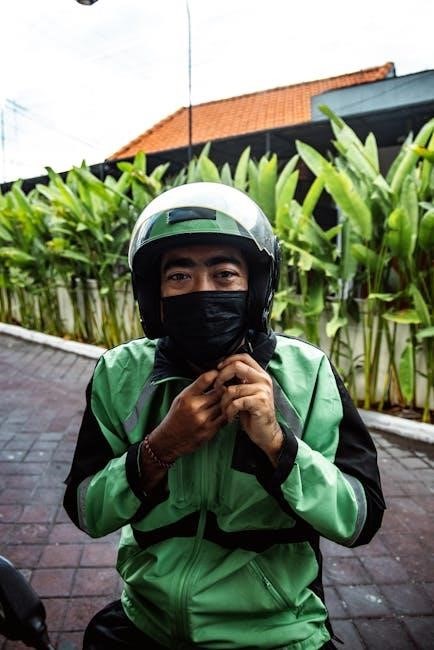A well-fitting motorcycle jacket is essential for safety, comfort, and performance while riding. This guide helps you navigate size charts, styles, and fit considerations to ensure optimal protection and comfort.
1.1 Importance of Proper Fit for Safety and Comfort
A well-fitting motorcycle jacket is crucial for both safety and comfort. A jacket that is too loose may compromise protection, as padding and armor may shift during impact. Conversely, a jacket that is too tight can restrict movement, affecting control and riding comfort. Proper fit ensures optimal protection, freedom of movement, and comfort, enhancing the overall riding experience. Always prioritize a snug yet comfortable fit to maximize safety and performance on the road.
1.2 Brief Overview of Motorcycle Jacket Styles
Motorcycle jackets come in various styles, each designed for specific riding needs. Cruiser jackets are classic and durable, often made of leather, while sport jackets prioritize aerodynamics and protection with reinforced padding. Adventure and touring jackets offer versatility for long-distance rides, combining durability and weather resistance. Casual and fashion jackets blend streetwear aesthetics with functional features. Understanding these styles helps riders choose a jacket that aligns with their riding preferences, ensuring both functionality and personal style.
Understanding Motorcycle Jacket Sizing Conventions
Motorcycle jackets use either alpha sizing (S, M, L) or numeric sizing (e.g., 40, 42), with charts based on chest and waist measurements to ensure proper fit.
2.1 Standard Size Charts and Measurements
Standard size charts for motorcycle jackets are based on specific body measurements, primarily chest and waist, to ensure a proper fit. These charts typically include ranges for chest circumference, sleeve length, and waist size, guiding riders to their ideal jacket size. Measurements are crucial for both comfort and safety, as a snug fit ensures protective features remain in place. Manufacturers often provide detailed charts, so riders can accurately determine their size, avoiding jackets that are too tight or too loose.
2.2 Differences Between Alpha and Numeric Sizing
Motorcycle jackets use two sizing systems: alpha (S, M, L) and numeric (44, 46, 48). Alpha sizes are simpler but less precise, while numeric sizes offer more accurate measurements, often based on chest circumference. Numeric sizing is common in leather jackets, providing a better fit for protective gear. Riders should consult the specific manufacturer’s chart, as sizing can vary between brands. Understanding these differences ensures the right fit, whether choosing alpha for convenience or numeric for precision.
How to Measure Yourself for a Motorcycle Jacket
Accurately measuring your chest, sleeves, and waist with a flexible tape measure ensures a snug, protective fit for your motorcycle jacket. Proper fit enhances safety and comfort.
3.1 Measuring Chest Size
Measuring your chest size is crucial for a proper motorcycle jacket fit. Wrap a flexible tape measure around the widest part of your chest, keeping it level and parallel to the ground. Ensure the tape is snug but not tight, with your arms relaxed at your sides. This measurement determines the primary fit of the jacket, as most sizing charts are based on chest dimensions. Accurate chest measurement ensures optimal protection and comfort while riding. Always refer to the manufacturer’s size chart for precise sizing guidance.
3.2 Measuring Sleeve Length
Measuring sleeve length ensures a comfortable and functional fit for your motorcycle jacket. Start by placing your arm slightly bent at a 90-degree angle. Measure from the center back of your neck, over your shoulder, and down to your wrist. This ensures the sleeves will not restrict movement while riding. Proper sleeve length prevents the jacket from riding up and keeps protective armor in place. Accurate measurements are essential, as sleeve lengths can vary slightly by manufacturer and jacket style. Always consult the specific size chart for the jacket you’re considering to ensure the best fit.
3.3 Measuring Waist and Hip
Measuring your waist and hip is crucial for ensuring a comfortable and secure fit in your motorcycle jacket. To measure your waist, wrap a flexible tape measure around your natural waistline, typically just above your belly button, keeping the tape level and snug but not tight. For your hip measurement, measure around the widest part of your hips, usually 7-9 inches below your waist. These measurements help determine how well the jacket will fit around your midsection, ensuring it stays in place while riding. Accurate waist and hip measurements are especially important if you prefer a more fitted jacket style.

How to Read a Motorcycle Jacket Size Chart
Understand the chart by matching your chest, waist, and sleeve measurements to the corresponding sizes. Proper fit ensures safety, comfort, and optimal protection while riding.
4.1 Interpreting Chest and Waist Measurements
Accurate chest and waist measurements are crucial for selecting the right motorcycle jacket size. Chest measurements typically range from small to 10XL, while waist sizes vary slightly. Ensure the jacket fits snugly but not overly tight, as a loose fit may compromise protection. Refer to the size chart to align your measurements with the corresponding size. Note that measurements can vary between manufacturers, so always check the specific chart for the jacket you’re considering. A proper fit ensures optimal safety, comfort, and mobility while riding.
4.2 Understanding Sleeve Length Measurements
Sleeve length is measured from the center of the neck, over the shoulder, and down to the wrist. Proper fit ensures sleeves aren’t too short or too long, allowing ease of movement while riding. Jackets with adjustable cuffs can fine-tune the fit. Ensure sleeves cover wrists fully when arms are bent. Refer to the size chart for accurate measurements, as sleeve lengths vary slightly between brands; A well-fitting sleeve enhances both comfort and protection, making it a critical factor in choosing the right jacket.

Factors Influencing Jacket Fit
Body type, riding style, and intended use significantly impact jacket fit. Riders with broader shoulders or longer torsos may need tailored sizes for optimal comfort and protection.
5.1 Riding Style and Jacket Fit
Riding style significantly influences jacket fit, as different styles require varying levels of mobility and protection. Sport riders need a snug, aerodynamic fit to reduce wind resistance and ensure armor stays in place. Cruiser riders may prefer a slightly looser fit for comfort during long, upright rides. Touring riders often opt for jackets with adjustable features to accommodate varying weather conditions and riding positions. Ensuring the jacket aligns with your riding style enhances both safety and comfort on the road.
5.2 Body Type and Jacket Size
Body type plays a crucial role in determining the ideal motorcycle jacket size. Taller riders may require longer sleeves, while broader chests need a jacket with a comfortable chest measurement. Athletes or those with muscular builds often prefer a slightly roomier fit for ease of movement. Smaller frames should avoid oversized jackets to ensure proper protection and mobility. Manufacturers typically design jackets with these variations in mind, offering size charts to help riders find the best fit for their body type and riding needs.
5.3 Intended Use of the Jacket
The intended use of a motorcycle jacket greatly influences its fit and size requirements. Jackets designed for casual rides may prioritize comfort, while sport or racing jackets focus on snugness and protection. Touring jackets often accommodate additional gear, requiring a slightly looser fit. Ensure the jacket aligns with your riding style, whether cruising, commuting, or off-road adventures, to maximize both safety and comfort. Proper fit ensures protective features function as intended, making the jacket’s purpose-aligned design essential for optimal performance.
Choosing the Right Jacket Style for Your Body Type
Selecting a jacket style that complements your body type ensures optimal fit and comfort. Cruiser jackets suit broader frames, sport jackets fit slim builds, while adventure jackets offer versatility for all riders.
6.1 Cruiser Jackets
Cruiser jackets are designed for comfort and durability, often featuring classic styles with a relaxed fit. They are typically made from high-quality leather, offering excellent protection and a timeless look. These jackets are ideal for riders with broader frames or those who prefer a more casual, laid-back design. Cruiser jackets usually include adjustable waistbands and ample storage pockets, making them practical for long-distance rides. Their sturdy construction and comfortable fit make them a popular choice among touring and cruiser motorcycle enthusiasts seeking both style and functionality.
6.2 Sport Jackets
Sport jackets are tailored for performance and agility, often featuring a slimmer, aerodynamic design; They are typically made from lightweight, breathable materials like mesh panels and stretch fabric for flexibility. These jackets are equipped with built-in armor at the shoulders, elbows, and back for enhanced protection during high-speed riding. Sport jackets are ideal for riders with a lean or athletic build, offering a snug fit that minimizes drag. Their focus on both performance and safety makes them a top choice for track and sport bike enthusiasts seeking precision and protection.
6.3 Adventure and Touring Jackets
Adventure and touring jackets are designed for long-distance riding, offering durability and versatility. They often feature waterproof and breathable materials, such as Gore-Tex or similar technology, to withstand varying weather conditions. These jackets typically include multiple pockets for storage, adjustable cuffs and hem, and reinforced padding for added protection. They are ideal for riders who prioritize comfort over long distances and need a jacket that can adapt to different climates and terrains. The fit is slightly relaxed to accommodate layers for colder conditions, making them a practical choice for extended tours.
6.4 Casual and Fashion Jackets
Casual and fashion motorcycle jackets blend style with functionality, perfect for everyday wear. They often mimic iconic designs, like bomber or denim jackets, while incorporating subtle protective features. These jackets may use lighter materials and minimal armor, prioritizing a stylish look over heavy-duty protection. Ideal for short commutes or casual rides, they offer a trendy alternative without compromising on basic safety. The fit is usually slim or tailored, appealing to riders who value aesthetics and want a versatile jacket for both on and off the bike.

Material and Fit Considerations
When choosing a motorcycle jacket, material and fit are crucial. Leather offers durability and protection, while textile jackets provide versatility for varying conditions. A snug fit ensures safety, with adjustable features allowing customization for optimal comfort and protection.
7.1 Leather vs. Textile Jackets
Leather and textile jackets offer distinct benefits for motorcyclists. Leather jackets are renowned for their durability and abrasion resistance, making them a top choice for protection in high-impact situations. They often feature built-in armor for added safety. On the other hand, textile jackets are lightweight, breathable, and versatile, suitable for varying weather conditions. They are typically made from materials like polyester or nylon, offering flexibility and comfort. Both materials cater to different riding styles and preferences, ensuring optimal performance and protection. Choosing between them depends on your specific needs and the type of riding you’ll be doing most often.
7.2 Adjustable Features for Custom Fit
Motorcycle jackets often include adjustable features like cuffs, waist straps, and elbow adjustments to ensure a tailored fit. These elements allow riders to customize the jacket to their body, enhancing both comfort and safety. Adjustable cuffs prevent wind intrusion, while waist straps provide a snug fit around the torso. Some jackets also feature adjustable armhole gussets for improved mobility. These customization options help achieve a balance between protection and flexibility, ensuring the jacket moves naturally with the rider’s body during various riding positions and maneuvers.
Common Fit Issues and Solutions
Addressing common fit issues like restrictive movement or poor armor placement ensures optimal protection and comfort. Adjustments like velcro straps or tailored alterations can resolve these problems effectively.
8.1 Jackets That Are Too Tight or Too Loose
A jacket that is too tight restricts movement, while one that is too loose may compromise safety by shifting during riding. Ensure a snug fit without sacrificing freedom of movement. If the jacket feels restrictive, consider a larger size or adjustable features like Velcro straps. Similarly, a loose jacket may require a smaller size or additional adjustments to keep protective armor in place. Proper fit is crucial for both comfort and safety, ensuring optimal protection in case of an accident. Always refer to size charts for accurate measurements.
8.2 Sleeve Length Adjustments
Ensuring proper sleeve length is vital for comfort and protection. Sleeves should reach your wrists while your arms are slightly bent. If sleeves are too short, consider a larger size or adjustable cuffs. Many jackets feature Velcro or zipper adjustments at the wrists to customize fit. Additionally, some styles offer adjustable shoulder straps or elbow panels for a tailored feel. Proper sleeve length prevents excess material from bunching, ensuring freedom of movement and keeping protective padding in place. Always check measurements and adjust as needed for optimal safety and comfort.

Case Studies: Finding the Right Size
Real-life examples illustrate how riders achieved the perfect fit. A female rider, 5’5″ and 135 lbs, found a size M jacket ideal for comfort and protection while riding.
9.1 Example 1: Male Rider
A male rider, standing at 6’1″ and weighing 190 lbs, found his ideal jacket size by following the guide. With a chest measurement of 42″ and a sleeve length of 24″, he opted for a size 44 jacket. This ensured a snug fit, providing optimal protection and mobility. The jacket’s armor aligned perfectly with his shoulders and elbows, while the tailored waist allowed for unrestricted movement. This example highlights the importance of precise measurements for a safe and comfortable riding experience.
9.2 Example 2: Female Rider
A female rider, 5’5″ and 135 lbs, determined her jacket size by measuring her chest (34″) and waist (28″). She chose a size M, ensuring a snug, protective fit without restricting movement. The jacket’s adjustable waist and sleeve cuffs provided a customized fit, while the armor aligned perfectly with her shoulders and elbows. This example demonstrates how precise measurements and style selection result in a comfortable, safe riding experience tailored to her body type and riding needs.
A properly fitted motorcycle jacket ensures safety, comfort, and confidence while riding. Use size charts, measure accurately, and consider style to find your perfect fit for optimal protection.
10.1 Final Tips for a Perfect Fit
Ensure a snug yet comfortable fit by referencing size charts and measuring accurately. Try jackets while sitting to replicate riding posture. Consider material stretch and adjustable features for customization. Prioritize styles that match your riding style and body type. Always test the fit with gloves on to avoid sleeve restrictions. By following these guidelines, you’ll find a jacket that balances safety, comfort, and style for an optimal riding experience.

Additional Resources
Additional resources include official manufacturer size charts, online fitting tools, and instructional videos to ensure a perfect fit and enhance your shopping experience.
11.1 Manufacturer Size Guides
Most manufacturers provide detailed size charts to help you choose the right jacket. These guides typically include chest, sleeve, and waist measurements, ensuring a precise fit. Brands like Dainese and others often offer sizing specific to their designs, such as sport or touring jackets. Some charts may also include hip measurements for certain styles. Always refer to the manufacturer’s guide for the jacket you’re interested in to ensure accuracy. This resource is invaluable for finding your best fit and optimizing safety and comfort on the road.
11.2 Online Fitting Tools and Videos
Online fitting tools and videos are excellent resources for determining your motorcycle jacket size. Many retailers offer virtual size guides and video tutorials that demonstrate how to measure yourself accurately. These tools often include interactive features, such as virtual try-ons or size recommenders, to help you find the perfect fit. Videos provide step-by-step instructions, making the process easier and more visual. Utilizing these resources ensures a more accurate fit, boosting confidence in your purchase and enhancing your riding experience with optimal comfort and protection.

Leave a Reply
You must be logged in to post a comment.